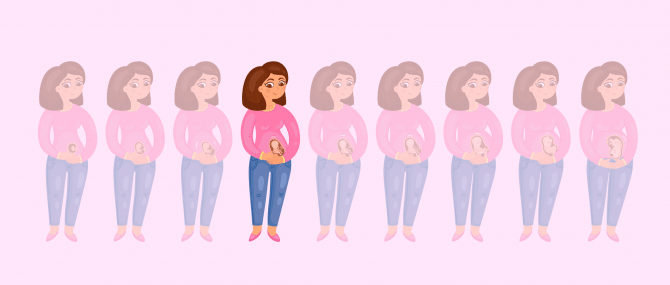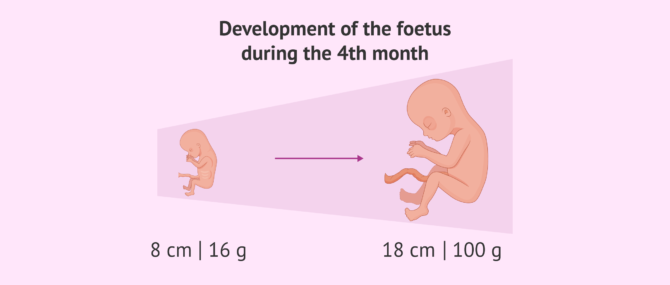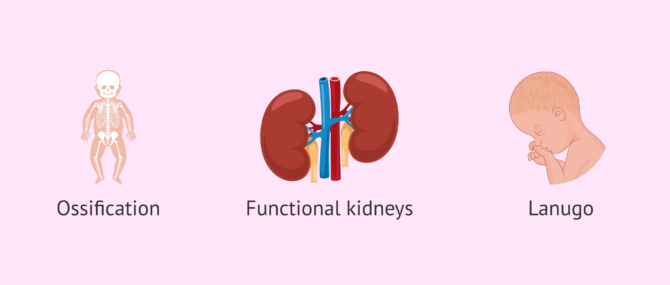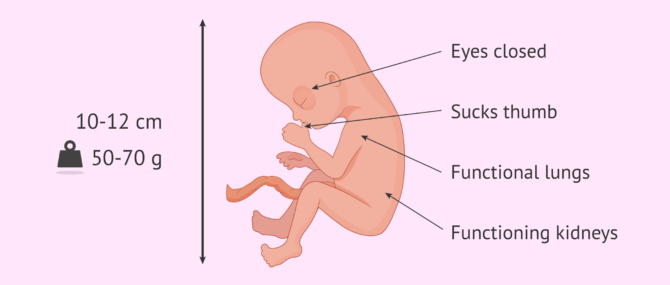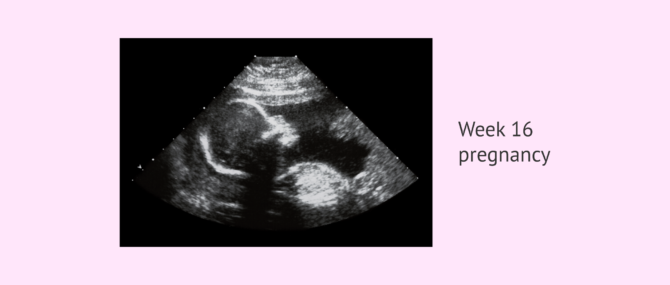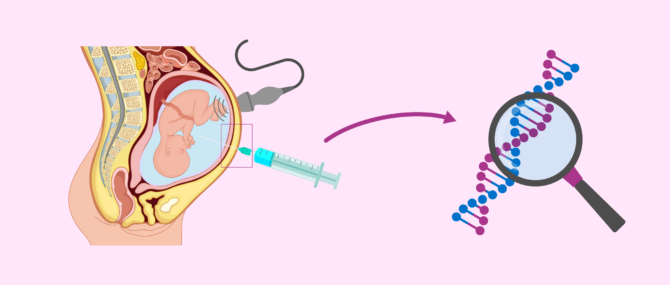The fourth month of pregnancy marks the beginning of the second trimester and covers from week 13 to week 16. The miscarriage rate is considerably lower now, and the symptoms of the pregnant woman are not so annoying than in previous months, since nausea disappears in most of the cases.
The fetus continues developing, growing from 8 cm to up to 18 cm, and gaining weight. By the end of month 4, the average weight of the fetus is 100 g. In some cases, guessing the gender via ultrasound scan is possible during this month.
Provided below is an index with the 9 points we are going to expand on in this article.
- 1.
- 2.
- 3.
- 3.1.
- 3.2.
- 3.3.
- 3.4.
- 4.
- 5.
- 6.
- 6.1.
- 6.2.
- 6.3.
- 6.4.
- 6.5.
- 6.6.
- 6.7.
- 7.
- 8.
- 9.
Symptoms to expect
During this month of pregnancy, your belly continues growing, slowly acquiring a protruding appearance. At this stage of pregnancy, women already show, since the uterus is growing and continues ascending into the abdominal area, being a few centimeters below your belly button.
Your uterus growing causes abdominal cramps and adds pressure to your bladder. This is the reason why pregnant women feel like they need to urinate more frequently than normal. Also, your enlarged uterus presses down on the sciatic nerve and causes nocturnal leg cramps.
Breasts go through a series of changes, too. The size of the nipples increases, areolas get darker, and the vessels become more noticeable due to changes in blood flow. These vascular alterations can cause bleeding gums and nose, known as gingivorrhagia and epistaxis, respectively.
All these developmental changes will cause you to gain a considerable amount of weight, averaging from 4 to 5 more kilograms.
Hormonal changes in the fourth month of pregnancy
From this moment on, pregnancy hormones will start declining and leveling off for the remainder of pregnancy. In comparison with the previous month, human chorionic gonadotropin (beta-hCG subunit) levels have diminished, whilst those of progesterone and estrogen increase. This stability of beta-hCG causes nausea and vomiting to subside or even go away.
Increased levels of estrogen and progesterone cause an increase in the production of melanin by the end of month 4, accompanied by the appearance of spots and the so-called linea nigra (darkening of the linea alba).
Hormonal changes are responsible for frequent forgetfulness, which is likely to worsen as the pregnancy progresses, hence the common term last-trimester fog. Being forgetful during pregnancy is normal, and is caused by structural changes that occur in the brain to prepare for motherhood.
You will also become more emotionally stable, with a more positive and relaxed attitude. The fear of miscarrying decreases, since the vital organ of the baby are fully formed and the placenta has completed its development.
Some pregnant women start feeling baby movements, especially those who have already been pregnant in the past, as their uterine walls have a reduced abdominal muscle tone.
Changes week by week
During this month the embryo goes through some important changes:
- The size increases from 8 cm at the beginning of the fourth month to roughly 18 cm at the end.
- The weight also increases. The amount may vary but usually ranges reaches 100 g by the end of this month.
By the time the baby-to-be reaches the fourth month of pregnancy, it is able to gesture and make more movements. The following details how the foetus develops week by week during this fourth month.
Week 13
From this week on, cartilage tissue starts the ossification process, that is, the bones harden. Also, the kidneys are fully functional and start producing urine.
Moreover, during the 13th week, a layer of hair starts to grow all over the body, nearly covering it. This thin hair is called lanugo. It starts growing around the eyebrows and mustache, and helps to maintain body temperature. It is normally shed before childbirth.
Continue reading: The Thirteenth Week of Pregnancy.
Week 14
At the 14th week, a small layer of hair grows in the head and the eyebrows are formed.
The external ear moves upwards, next to its definitive location in the head. The eyes still remain huge, closed and separated, although they are closer than in the previous month. The fetus has now a grown neck and its face is well-formed. Moreover, some facial expressions can be envisaged now.
The arms grow as well, and now they are compensated in comparison with the rest of the body. At this point, the fetus has nails on the fingers.
The liver is too large if compared to other internal organs because it is in charge of producing blood cells. From this week on, the bone marrow will do part of this task, but the liver continues having a key role. When the baby is born, the bone marrow will be the only organ in charge of this function.
The intestine begins to be filled with a thick substance secreted by the liver and called meconium, composed of bile, mucus, and other secretions.
At this stage of pregnancy, fetal movement is considerably noticeable, since it has plenty of space in the uterus to move freely.
Click here to read more: The Fourteenth Week of Pregnancy.
Week 15
At the 15th week, the hair on the head and eyebrows becomes thicker. The fetus moves vigorously now, and is able to open and close the hands frequently.
Many gestures can be observed, suck as yawning or opening and shutting the mouth. Muscles of the face are able to do sucking movements, and the fetus can suck his/her thumb now. Thanks to this, the muscles of the baby-to-be prepare for breastfeeding once born.
If the future baby has the genes of dark hair, the pigmentary cells of the hair follicles will start to develop the black pigment.
The eyes are still shut, but the ocular structures that will allow him or her to see following birth are forming.
To learn about the events that take place throughout this week, read: The Fifteenth Week of Pregnancy.
Week 16
In week 16, the baby-to-be keeps growing. Moreover, head and body are more proportionated. The neck is starting to have its proper form.
Fetal movement is increasingly becoming more energetic. In fact, it is controlled by the brain now. The nervous system becomes functional, and the fetus develops the grasp reflex, which causes him/her to close the hands and fingers whenever they touch something.
Fetal sense of touch develops at this stage as well. The epidermal fold of the palm of the hand and fingers appear. Now the new being has already fingerprints.
Although the eyes continue being shut, he or she is able to move them.
You may also enjoy some further information reading this: The Sixteenth Week of Pregnancy.
Amniocentesis
Amniocentesis, commonly referred to as amnio test, is a diagnostic test that consists in aspirating a small amount of amniotic fluid for analysis. Thanks to it, experts can detect malformations in the neural tube, metabolic abnormalities, or genetic anomalies, like Down syndrome.
Indicated in patients with greater risk for transmitting birth or chromosomal defects to offspring, as in the case of women of advanced maternal age, or who have experienced similar issues in previous pregnancies.
Amniocentesis should be performed from week 15 onwards. If done earlier, the amount of amniotic fluid available is very low, which increases the risk for the fetus.
One should note that amnio testing has fallen into disuse in the past few years due to the emergence of new diagnostic techniques that require just a blood sample. In other words, non-invasive, safer methods for the fetus.
Care in the fourth month of pregnancy
The changes during pregnancy are diverse and it is a period of vulnerability for both the mother's and the baby's health. Therefore, good care during pregnancy is essential.
In addition to medical tests, it is important to follow a healthy diet. The nutrient intake during pregnancy must be adequate, as it will help the baby's development. Specialists advise eating bananas, sultanas or any food with a high potassium content. These foods will prevent leg cramps.
Oral hygiene should not be forgotten, as during pregnancy there is a greater risk of gingivitis and other oral disorders.
Finally, doing sport, giving up smoking, reducing caffeine consumption, wearing comfortable clothes and shoes, taking care of your posture and moisturising your skin are other tips for this fourth month of pregnancy, although they can be applied at any time during pregnancy.
FAQs from users
In pregnancies achieved with IVF or ICSI, do fetuses grow at the same rate than in natural pregnancies?
Babies grow at the same pattern irrespective of how they were conceived and the type of pregnancy (natural or using reproductive techniques). A different concept is fetal growth in relation to the weeks of pregnancy, which may be influenced by multiple factors, and has been associated with intrauterine growth restriction in artificial pregnancies in comparison with spontaneous or natural pregnancies.
I am 15 weeks and not feeling baby move, should I be worried?
If the results of medical testing are positive, there is no reason for you to be concerned, since each fetus has a different development path. Moreover, in the case of first-time moms, it is still too early for them to feel the baby moving. For those who have been pregnant in the past, they are more likely to feel some movement. In any case, it is normal that you still don't feel anything at this stage of development.
Should I have an amniocentesis even if it is not required in my case?
Amniocentesis (amnio test) is an invasive procedure that can damage the fetus and compromise its viability. Before making a decision, it should be medically assessed and determine if the risks are worth the benefits of this procedure. Simply put, if your OB/GYN considers that it is unnecessary, we recommend that you follow his or her instructions.
Is it OK to exercise in the fourth month of pregnancy?
Absolutely yes. In fact, it is strongly recommended. In this month, a number of pregnant women start feeling fine physically, and full of energy. Moreover, the miscarriage rate has decreased substantially. In other words, it is the perfect moment for you to start practicing moderate sport, like walking, yoga, or swimming.
Recommended for you: Physical Activity and Exercise During Pregnancy.
What are the measurements of a four-month-old foetus?
By the fourth month of pregnancy, the foetus is about 18 cm long and weighs about 100 grams. However, the foetus will continue to develop and its organs will gradually mature.
Can you tell if it is a boy or a girl in the fourth month of pregnancy?
It is most common to wait until 18-22 weeks of pregnancy to find out the sex of the baby. However, it is sometimes possible to know if it is a boy or a girl earlier by ultrasound.
What medical tests are performed in the fourth month of pregnancy?
Throughout the pregnancy, the specialist will advise you to undergo various medical tests. Through these, the doctor will check that the pregnancy is progressing correctly.
Specifically, in the fourth month of pregnancy, second trimester biochemical screening is indicated. Thanks to this biochemical study it is possible to rule out chromosomal alterations in the foetus. If the result is that there is a high risk of chromosomal abnormalities in the foetus, the specialist will recommend a non-invasive maternal blood test or amniocentesis.
Another test recommended in the fourth month of pregnancy is an ultrasound scan to observe the movement of the baby.
Suggested for you
Throughout this post, we have made several references to lanugo, a key part of the developing fetus that has a protective role. Click here to read more: What Is Lanugo?
On the other hand, you can continue reading about the next month of pregnancy here: The Fifth Month of Pregnancy Week by Week.
We make a great effort to provide you with the highest quality information.
🙏 Please share this article if you liked it. 💜💜 You help us continue!
References
Alcolea Flores, S., Mohamed Mohamed D. Guía de cuidados en el embarazo. Consejos de su matrona. Hospital Universitario de Ceuta (Dirección Territorial de Ceuta e Instituto Nacional de Gestión Sanitaria (ed.). Colección Editorial de Publicaciones del INGESA. ISBN: 978-84-351-0408-1 (View)
Consejería de Salud de la Junta de Andalucía (2002). Proceso Asistencial Integrado: Embarazo, Parto y Puerperio. Consejería de Salud, Junta de Andalucía. Sevilla (View)
Cunningham F, MacDonald P, Gant N et al. (1996). Adaptación maternal al embarazo. Masson SA. Cunningham F, MacDonald P, Gant N, et al. 4ª ed, Barcelona; pp. 201-237
Duyff, R.L. (2002). American Dietetic Association Complete Food and Nutrition Guide (2nd Ed.). Hoboken, New Jersey: John Wiley & Sons, Inc
Eugene S, Bonapace MD, Robert S, Fisher MD. (1998). Constipation and diarrhea in pregnancy. Gastroenterol Clin North Am; 27: 197- 211 (View)
Gary F, Mc Donald P. (1996). Adaptación materna al embarazo. En: Gary F, MacDonald P, Grant N Lereso K, Gilstrap L, editores. Williams. Obstetricia (4.a ed.). Barcelona: Masson.
González Merlo J. (1992). Modificaciones fisiológicas producidas en el organismo materno por el embarazo. En: Williams. Obstetricia (4.a ed.). Barcelona: Masón (View)
National Health Service (NHS) (UK) (2009). The Pregnancy Book. Your complete guide to: A healthy pregnancy, Labour and childbirth, The first weeks with your new baby. Crown copyright 2009. Produced by COI for the Department of Health.
Ramírez García O, Martín Martínez A, García Hernández JA. (2003). Duración del embarazo. Modificaciones de los órganos genitales y de las mamas. Molestias comunes del embarazo normal. Panamericana Ed. Tratado de Ginecología, Obstetricia y Medicina de la Reproducción. Cabero Roura L, Madrid.
The American Dietetic Association. (2008) Position of the American Dietetic Association: Nutrition and Lifestyle for a Healthy Pregnancy Outcome. Journal of the American Dietetic Association. 108:553-561.
U.S. Food and Drug Administration (FDA). Food Safety for Moms-To-Be. Retrieved April 09, 2010
FAQs from users: 'In pregnancies achieved with IVF or ICSI, do fetuses grow at the same rate than in natural pregnancies?', 'I am 15 weeks and not feeling baby move, should I be worried?', 'Should I have an amniocentesis even if it is not required in my case?', 'Is it OK to exercise in the fourth month of pregnancy?', 'What are the measurements of a four-month-old foetus?', 'Can you tell if it is a boy or a girl in the fourth month of pregnancy?' and 'What medical tests are performed in the fourth month of pregnancy?'.
